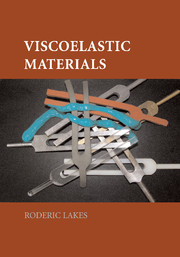Book contents
- Frontmatter
- Contents
- Preface
- 1 Introduction: Phenomena
- 2 Constitutive Relations
- 3 Dynamic Behavior
- 4 Conceptual Structure of Linear Viscoelasticity
- 5 Viscoelastic Stress and Deformation Analysis
- 6 Experimental Methods
- 7 Viscoelastic Properties of Materials
- 8 Causal Mechanisms
- 9 Viscoelastic Composite Materials
- 10 Applications and Case Studies
- A Appendix
- B Symbols
- Index
3 - Dynamic Behavior
Published online by Cambridge University Press: 21 January 2010
- Frontmatter
- Contents
- Preface
- 1 Introduction: Phenomena
- 2 Constitutive Relations
- 3 Dynamic Behavior
- 4 Conceptual Structure of Linear Viscoelasticity
- 5 Viscoelastic Stress and Deformation Analysis
- 6 Experimental Methods
- 7 Viscoelastic Properties of Materials
- 8 Causal Mechanisms
- 9 Viscoelastic Composite Materials
- 10 Applications and Case Studies
- A Appendix
- B Symbols
- Index
Summary
Introduction and Rationale
The response of viscoelastic materials to sinusoidal load is developed in this section, and this response is referred to as dynamic. Dynamic in this context has no connection with inertial terms or resonance. The dynamic behavior is of interest because viscoelastic materials are used in situations in which the damping of vibration or the absorption of sound is important. The results developed in this section have a bearing on applications of viscoelastic materials, on experimental methods for their characterization, and on the development of physical insight regarding viscoelasticity.
The frequency of the sinusoidal load on an object or structure may be so slow that inertial terms do not appear (the subresonant regime), or high enough that resonance of structures made of the material occurs. At a sufficiently high frequency, dynamic behavior is manifested as wave motion. This distinction between ranges of frequency does not appear in the classical continuum description of a homogeneous material, because the continuum view deals with differential elements of material.
Oscillatory stress and strain histories are represented by sinusoid functions. Suppose we have α(ωt) = α0sinωt, in which t is time, α0 is the amplitude, and ω is the angular frequency. The sine function repeats every 2π radians. So α(ωt + 2π) = α(ωt). The time T required for the sine function to complete one cycle is obtained from ωT = 2π, or T = 2π/ω. T is called the period, the number of seconds required for one cycle.
- Type
- Chapter
- Information
- Viscoelastic Materials , pp. 55 - 90Publisher: Cambridge University PressPrint publication year: 2009
- 4
- Cited by



